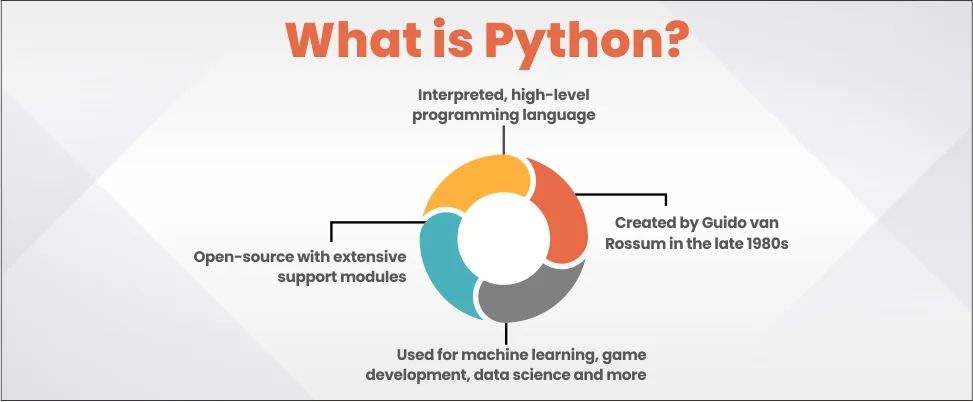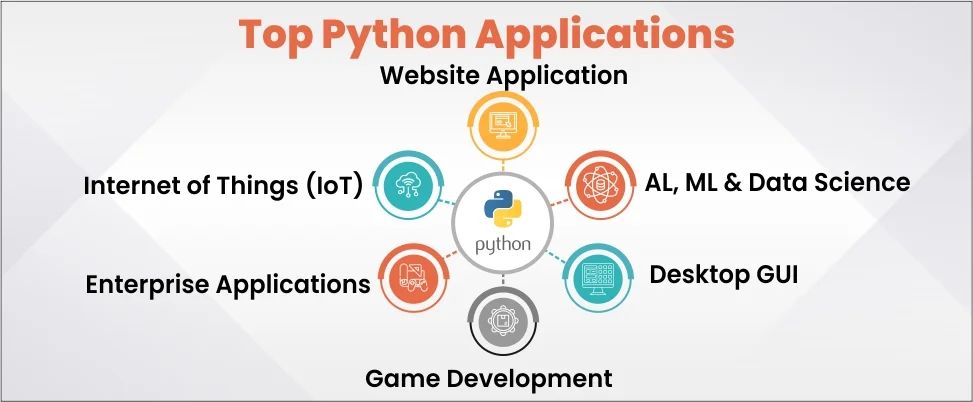Table of Contents
ToggleIntroduction
Python is a high-level programming language popular for its versatility and simplicity. Introduced in the late 1980s, Python has grown into a language of choice for developers working on building diverse applications. From web and desktop apps to software for artificial intelligence (AI) and Internet of Things (IoT), Python is popular among beginners and seasoned developers. Around 48.28% of developers use Python, which makes it one of the most used programming languages as of 2023. In this blog, let’s learn more about Python, its features, and applications.
What is Python?

Created by the Dutch programmer Guido van Rossum in the late 1980s, Python is an interpreted, object-oriented, high-level programming language. It is an open-source, general-purpose programming language that is easy to learn, and has extensive support modules from a large community of developers. Python is extensively used for machine learning and deep learning applications, development of 2D imaging and 3D animation packages, popular video games, and scientific and computational applications.
According to Stackoverflow’s Developer Survey for 2023, 56.57% of those learning to code use Python, after HTML/CSS and JavaScript. Also, it is the most used language by Other Coders (those who are not professional developers or learning to code).

Advantages of Using Python
- Free and Open Source : Python is completely free to use as it was developed under an OSI-approved open-source license language. You can download it from the official website and even use it freely for commercial purposes. Programmers can download source code and share it publicly.
- Easy to Code and Read: Python is easy to understand or interpret compared to C, C#, JavaScript, Java, etc. As it can be grasped easily, it is often known as a developer-friendly language. Further, the code block of Python is defined by the indentations instead of semicolons or brackets. This makes its syntax straightforward and easy to learn.
- Object-Oriented Language: Python focusses on the design around data and objects and not on functions and logic. Python’s OOP paradigm uses objects and classes in programming and aims at employing real-world entities like inheritance, polymorphisms, and encapsulation in the programming.
- GUI Programming Support: Python offers support for GUI or Graphical User Interface. Python programmers can easily use the toolkits like Tkinter, wxPython and JPython, to develop GUIs (icons, menus, buttons, etc.) without any hassle.
- High-Level Language: Since high-level programming languages allow a program to be developed in a user-friendly way, Python programmers don’t need to remember the system architecture. In addition, they also don’t have to worry about memory management.
- Large Community Support: Python’s diverse, vast community consists of dedicated programmers actively contributing to its development. The support is available to beginners as well as experts, and helps the community grow its knowledge base.

- Easy to Debug: Python is easy to debug as it is a script and not a compiled program. Its simple syntax and easy-to-understand error messages make it easier for coders to identify and fix errors easily. Once you have learned it adequately, it is easy to understand the error traces and identify what the designed code is meant for.
- A Portable Language: Python code written for Mac can also be run on other platforms, such as Linux, Windows, and Unix. Since developers don’t need to write multiple programs for different platforms, using Python as a portable language is one of its top benefits.
- An Interpreted and Integrated language: Unlike other object-oriented languages, Python source code is executed line by line. Unlike C++ or Java, Python doesn’t have to be compiled first and then run. It is processed at runtime by the interpreter. Also, Python can be easily integrated with other languages like C# and C++.
- Large Standard Library: The vast library of Python offers a standard set of modules and functions rich enough to omit the need to write a code for every single thing. The Python Package Index has a growing collection of components and other functionalities available for anyone to use.
- Dynamically Typed Language: Python allows coders to decide the variable at runtime, which makes it a dynamically typed language. The variable types are not determined during compilation. This means that unlike statically typed languages, the code will be interpreted even if it contains an error.
- Frontend and Backend Development: Developers use Python to create front-end and back-end applications. Django and Flask Frameworks allow it to be used for back-end development. A new project py script allows you to write Python code in HTML and use it for front-end development.
- Dynamic Memory Allocation: As the type of variable data doesn’t require specification, it is possible to allocate a memory to a variable automatically during runtime. When a system is not being used, the reference counting system and garbage collector automatically return memory to the system.

Don't miss out on your chance to work with the best
apply for top global job opportunities today!
Disadvantages of Python
- Slow Runtime: Python is a high-level language and is hence, further from hardware. It is slow compared to C/C++ or Java. Python code is executed line by line with an interpreter instead of a compiler. As a result, each variable has to be validated, which slows it down at runtime.
- Runtime Errors: Since Python is compiled directly at runtime, errors can be seen by the compiler only when the program is running. As a result, even a simple syntax error might not be caught when the program is being compiled which can be a challenge to debug.
- Memory Intensive: Python garbage collector does not collect the disposed resources immediately. As a result, it uses more RAM than other programming languages.

- Limited Mobile App Development: Although Python has mobile application frameworks like Kivy and Beeware, there are better options available, such as Flutter and React Native. Since Python uses a lot of memory and is slow at runtime, it is often not the most preferred choice for developing mobile applications.
- No Multithreading Support: Python runs each thread separately by using multiprocessing, which stops multiple threads from executing Python code at once. The Global Interpreter Lock (GIL) mechanism in Python prohibits it from multithreading, which leads to performance limitations for CPU-bound tasks. This can reduce output and cause scalability issues, as GIL can cause a bottleneck in multi-threaded applications with significant Python code execution.
- Not Optimized for Database Access: Unlike Java Database Connectivity (JDBC), Python does not have a powerful high-quality interface that is easy to use. As a result, developers might find it tedious to work with Python databases. However, Python can still be used if the databases are straightforward. Nevertheless, Python is not the preferred choice for apps that have complex interactions with a large corporate database.
- Prone to Misuse or Overuse: Python is a simple programming language, but it also poses as a drawback. If a programmer gets too comfortable with the simple syntax of Python, they might avoid using other languages for coding despite the necessity. In addition, as it is easy to use, it can be overused for tasks where it is not the best option. Python is a great choice for rapid development and prototypes, but businesses should not neglect proper software development principles while using it.
Use Cases and Applications of Python
A few drawbacks do not stop developers from using Python for a variety of applications. A programming language like Python, which is based on data, is intuitive. As a result, developers find it easy to understand and apply Python. It has a wide range of applications and is used extensively in web applications and software development. Moreover, it can also be used in AI and ML applications.
Top Python Applications

- Website Application: Developers who know Python can build robust web applications using the common back-end logic of Python. It can easily integrate with protocols like SSI and HTTPS and offer XML and JSON support. Python-based web frameworks like Django, Pyramid, and Flask can be used to manage backend or server-side functionality of sites. Spotify, Google, and YouTube are a few companies that rely on Python for critical functions.
- Data Science: Python offers impressive data handling and visualization and is a great choice for developing apps for Data Science. NumPy, Matplotlib and Pandas are a few libraries that help developers visualize data efficiently, gain insights, and identify patterns in AI model designs. For instance, Python was used by NASA to simulate the Mar Rover’s movements in various terrains to help plan its path and operations.
- Artificial Intelligence and Machine Learning: Python’s prebuilt libraries make coding easier for Al and ML applications. Many companies use Python to manage computation, build machine-learning models, and develop solutions like image recognition, data processing, and advanced computing. Python libraries such as AIMA, pyDatalog, and SimpleAI are widely used in general AI. On the other hand, PyBrain offers flexible algorithms to perform Machine Learning tasks.
- Internet of Things: Many IoT systems with remote sensor networks, big data and data analysis, automation, and machine learning employ Python programming to run the intuitive interfaces. For example, the MQTT protocol for the IoT in Python enables high-speed data exchange with low payload communication between the devices.
- Game Development: PyKyra, Pygame, PyOpenGL, Pyglet, Panda3D, Kivy, and Cocos2D are the popular Python game development frameworks. Some popular games developed using Python are Snake, Sims 4, World of Tanks, and Disney’s Toontown Online.
- Enterprise Applications: Large organizations around the world use Python to build enterprise applications. Companies that analyze data and automate operations to build enterprise applications using DevOps use Python extensively. Python’s scalability and readability also makes it a great choice for ERP.
- Desktop GUI: There are a few excellent Python GUI frameworks that help build compelling user interfaces. Tkinter, PyQt, Kivy, and PySide offer great tools that can be used to create many applications, including simple data entry forms and complex multi-touch mobile apps.
Conclusion
As more and more businesses turn to ‘remote first’ models and embrace technological advancements, many software development companies are being roped in for Rapid Application Development. The dynamic semantics and the high-level programming of Python make it a top choice to help businesses build a versatile yet scalable infrastructure. Python’s simplicity, readability, and versatility make it a preferred language for a wide spectrum of applications, from web development to artificial intelligence and beyond. Not only this, but its growth is also evident from the increase in employment opportunities. Python shows great promise through the dynamic tech ecosystem promising innovation and efficiency for developers worldwide.
FAQs
Python is a programming language that is known for its simplicity, readability, versatility, and extensive community support. It can be used for web development, data science, artificial intelligence, and automation.
C++ has more syntax rules and program conventions than Python. As Python has an easy-to-learn syntax, it is easier to learn.
Python is a free and open-source language. You can download it from the official Python website, and its source code can be freely accessed and shared.
Yes, because it has a high-level syntax and code blocks defined by indentation. Python emphasizes readability making it more straightforward compared to languages with explicit delimiters.
Web development, game development, data science, AI and ML, and enterprise applications are some of the domains where Python is extensively used.
Take control of your career and land your dream job
sign up with us now and start applying for the best opportunities!




